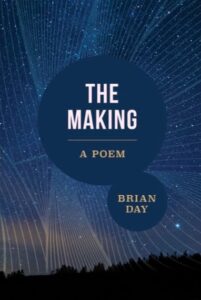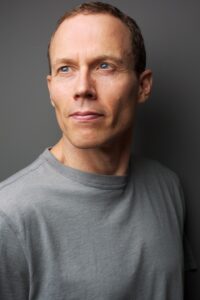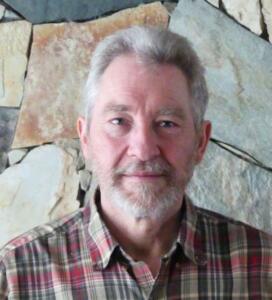The ‘myths of our making’
The Making: A Poem
by Brian Day
Eugene: Resource Publications, 2024
$30.00 / 9781666779479
Reviewed by Harold Rhenisch
*

Brian Day praises the universe and storytelling, argues that they are the same thing, and proposes a new name for them together: The Making. Essentially, his goal is to allow you and I, his readers, to become the story that the Universe tells so that we can praise it. By praise, Day means that we can read the universe, in itself and in his book, and then save it from the sixth great extinction by retelling it in a living form. As Day proclaims in “15. Niobe Watches Her Progeny Erased,” “If there is some way for us to proceed, / it might be upon the footpaths of our stories, / upon the old wishes engraved on this world.”
Salt Spring Island resident Day (The Daring of Paradise) envisages saving the Earth from mechanization. By machines, he means stories, nation-states, individualism, and bulldozers, all together. His method is to link stories of (largely Middle Eastern and Asian) gods, European folk tales, a Haida raven and a woman in the star country of Interior Indigenous culture to specific moments in the story of evolution. His goal is to place a moment of revelation within each stage of evolution, to express Creation wishing its way into change.
Day’s universe in The Making is a place of wishing, and the fulfillment of those wishes. Its intelligence is not the individual male God of Judeo-Christian tradition passing judgement. Neither is it humanism or religious obedience that creates the local difference that, a poem like “7. God Makes a New Deity” contends, creates war: “There is nothing to be done but to attempt to engender / new deity—fusing, surpassing individual magics.”
Day wants everyone to come together.

Day has context. In 1944, in the last full year of World War II, the Danish writer Johannes Vilhelm Jensen won the Nobel Prize in Literature for a series of novels called The Long Journey. In form, Jensen’s series was similar to Day’s The Making—more a richly narrativized argument than a story with traditional characters, plot, rising action, climax, and denouement.
The Long Journey also presented human evolution as a search for a tropical paradise, driven by the “Scandinavian” values of heroism, exploration, and settlement—all culminating in a startlingly blond and Nordic Columbus arriving in the Caribbean. That story eventually led to Juno Beach and the rescue of Europe from the thralldom and brutality of Nazism. Nationalist ideology saw evolution as a brutal fight to the death. Jensen saw evolution as an expression of hope.
Day is big on hope, too. In his retelling, evolutionary progress is periodically destroyed by mass extinctions, which spark the solutions that have led to human beings. Day places humans at the centre of the Universe’s experience, on an Earth that is at the spiritual centre of that Universe. His Sun is light, the source of good, in a world of darkness and decay.
It’s an ancient Mediterranean conception. Imported to Cascadia, it is also colonial. About that, as “8. Story and Dream” illustrates, Day clearly reads stories globally, for their parallels and connections, rather than locally, for intimacy:
we are restless
until we come to ourselves in story, until
we know ourselves bright with dream,
until welcomed, embraced, by the myths of our making.
Not all readers will agree with this laminated approach. More universal, perhaps, is that poetically Day’s ancient mythological threads are interwoven with luscious imagery, rolling metrical rhythms, and the freshness of his pairings of science and mythology. Many of those are quite revelatory. Here, for instance, in “11. Speech Ignites Muhammad’s Mouth,” is Muhammad on a beautiful desert night:
Language reverberates
on every audible horizon, and in every
direction he turns is the cascading angel.
Day’s metrics, however, are stretched by the poem’s length. Line by line, this long poem is very intricately thought out, in clear and often erudite language. At 160 pages, though, it eventually simply dazzles. Lyricism is not a plot point. Day’s evolutionary argument, for example, is linear: the Universe wishes to see itself as beautiful, and sets out to create the necessary viewers—humans, on a journey ultimately expressed as the reading of the Earth that is industrial technology. To critique such excess, Day writes in “2. Adam and Eve and the Arrival of Industry,”
They have wreaked untellable afflictions on the planet;
the world is in ruins and could not have advanced
without this precise verboten act.
The German verboten, forbidden, is startling but doesn’t particularly reveal the subtleties of German environmental and technical philosophy. One of the statement’s possible subtexts, that the horrors of the German wars in twentieth century Europe contributed to an increase of planetary care, is hard. The humans in such a scenario, presumably the Universe’s eyes and mouths in its stories of love and beauty, appear to be dispensable.
The stories told to link this progression to mythological revelation, on the other hand, are not in a linear progression. The Fisherman’s Wife of European folk tales is present with the dinosaurs. She is followed by the myth of Demeter and Persephone, which is followed by Mary, Jesus, and the first mammal tenderly suckling its first mouse child.
Such stories are illustrations, eternal moments, energies of the Earth erupting in forms initiated by the Big Bang. Or Yahweh. Raven, too, and the first men crawling out of a clam shell on North Beach in Haida Gwaii. To Day, they are all one expression. Unfortunately, that’s not as supple a conception as Bill Reid’s raven at UBC Museum of Anthropology, carved from startlingly white, laminated wood to carefully differentiate points of view as gestures of respect and integration.
But then, Day’s Judeo-Christian mythologies come from a newer culture, that stores memory in texts. The unification of points of view into moments of revelation and the replication of them millions of times as the awakening of the original revelation of love and being, is more important to him than individuals humbly retelling stories. To him, reading is seeing.
Of cave art, for instance, he writes in “13. Jesus is Rebuked. Art Takes Flight,”
people crept into caves with pots of pigment,
apprehended in the dark the figures of animals,
pressed their minds upon the unpainted world.
He could be describing his own method. He could be talking about Judaism. Or colonialism. He’s not talking about cave artists.
Instead, his path out of the Sixth Great Extinction is to to create a new divine being: the beautiful Earth, a water drop in space, wounded but still loved. To Day, the entire process of evolution comes down to telling this story in a book of praise.
Again, Day has context. This reimagining of the Judeo-Christian worldview echoes a similar one the poet Goethe made at the opening of the nineteenth century, in books on evolution and physics. Goethe also created a public park in Weimar, where the new Middle Class could stroll in an Italian landscape painting and contemplate its cultural roots in Rome in order to renew them while being renewed by fresh air.
Day does well to attempt to unify experience without the nationalism that Goethe’s individuality was harnessed to. That Day’s choice of stories draws only from those that easily illustrate his argument, and not ones that illustrate the give and take between humans, Earth, and spirits in the oral cultures of, for instance, Cascadia (where this book was written), is perhaps a sign of how large a task he has taken on, how purely he has made it, and how incomplete it remains.
But then, the Making is never done.

*

Harold Rhenisch has written thirty-five books from the Southern Interior since 1974. He won the George Ryga Prize for a memoir, The Wolves at Evelyn. His other grasslands books are Tom Thompson’s Shack and Out of the Interior. He lived for fifteen years in the South Cariboo and worked closely with photographer Chris Harris on Spirit in the Grass, Motherstone, Cariboo Chilcotin Coast, and The Bowron Lakes; and he writes the blog Okanagan-Okanogan. His The Salmon Shanties: A Cascadian Song Cycle will appear this fall. Harold lives in an old Japanese orchard on unceded Syilx Territory above Canim Bay on Okanagan Lake. [Editor’s note: Harold Rhenisch has reviewed books by Jason Emde, John Givins, DC Reid, Kim Trainor, Dallas Hunt, Tim Bowling, Hamish Ballantyne, Zoë Landale, Kerry Gilbert, Robert Hilles, Sho Yamagushiku, Bradley Peters, Aaron Tucker, Dale Tracy, Dominique Bernier-Cormier, Selina Boan, Joseph Dandurand, Délani Valin, Robert Bringhurst, Rayya Liebich, Sarah de Leeuw, Roger Farr, Stephan Torre, Don Gayton, and Calvin White for BCR. His book Landings was reviewed by Luanne Armstrong; The Tree Whisperer was reviewed by Adrienne Fitzpatrick.]
*
The British Columbia Review
Interim Editors, 2023-25: Trevor Marc Hughes (non-fiction), Brett Josef Grubisic (fiction and poetry)
Publisher: Richard Mackie
Formerly The Ormsby Review, The British Columbia Review is an online book review and journal service for BC writers and readers. The Advisory Board now consists of Jean Barman, Wade Davis, Robin Fisher, Barry Gough, Hugh Johnston, Kathy Mezei, Patricia Roy, Maria Tippett, and Graeme Wynn. Provincial Government Patron (since September 2018): Creative BC. Honorary Patron: Yosef Wosk. Scholarly Patron: SFU Graduate Liberal Studies. The British Columbia Review was founded in 2016 by Richard Mackie and Alan Twigg.
“Only connect.” – E.M. Forster